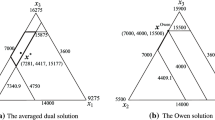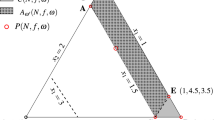Abstract
The paper analyzes cooperative games with side payments. Each player faces a possibly non-convex optimization problem, interpreted as production planning, constrained by his resources or technology. Coalitions can aggregate (or pool) members' contributions. We discuss instances where such aggregation eliminates or reduces the lack of convexity. Core solutions are computed or approximated via dual programs associated to the grand coalition.
Similar content being viewed by others
References
Aubin, J.P. and Ekeland, I. (1976), Estimates of the duality gap in nonconvex optimization, Mathematics of Operations Research 1: 225–245.
Aumann, R.J. and Shapley, L.S. (1974), Values of Non-Atomic Games, Princeton University Press, New Jersey.
Bertsekas, D.P. (1982), Constrained Optimization and Lagrange MultiplierMethods, Academic Press, New York.
Deng, X., Ibaraki, T., Nagamochi, N. and Zang, W. (2000), Totally balanced combinatorial optimization games, Mathematical Programming 87: 441–452.
Dubey, P. and Shapley, L.S. (1984), Totally balanced games arising from controlled programming problems, Mathematical Programming 29: 245–276.
Gale, D. (1978), The core of a monetary economy without trust, Journal of Economic Theory 19: 456–491.
Granot, D. (1986), A generalized linear production model: a unifying model, Mathematical Programming 43: 212–222.
Hart, S. (1982), The number of commodities required to represent a market game, Journal of Economic Theory 27: 163–169.
Hildenbrand, W. (1974), Core and Equilibria in a Large Economy, Princeton University Press, New Jersey.
Kalai, E. and Zemel, E. (1982), Generalized network problems yielding totally balanced games, Operations Research 30: 998–1008.
Kalai, E. and Zemel, E. (1982), Totally balanced games and games of flow: Generalized network problems yielding totally balanced games, Math. of Operations Research 7: 476–448.
Kaneko, M. and Wooders, M.H. (1986), The core of a game with a continuum of players and finite coalitions: The model and some results, Mathematical Social Sciences 12: 105–137.
Laurent, P.-J. (1972), Approximation et optimisation, Hermann, Paris.
Martínez Legaz, J.E. (1999), A new characterization of totally balanced games, in: Wooders, M. (ed.), Topics in Mathematical Economics and Game Theory, Fields Inst. Com. 23, Am. Math Soc. RI 83–88.
Mas-Colell, A. (1977), Competitive and value allocations of large exchange economies, J. Econ. Theory 14: 419–438.
Moulin, H. (1990), Joint ownership of a convex technology: comparison of three solutions, Review of Economic Studies 57: 439–452.
Moulin, H. (1996), Cost sharing under increasing returns: A comparison of simple mechanisms, Games and Economic Behavior 13: 225–251.
Owen, G. (1975), On the core of linear production games, Mathematical Programming 9: 358–370.
Peleg, B. (1992), Axiomatization of the core, in: Aumann, R. and Hart, S. (eds.), Handbook of Game Theory with Economic Applications I, pp. 397–412, North-Holland, Amsterdam.
Rockafellar, R.T. (1970), Convex Analysis, Princeton University Press, Princeton.
Samet, D. and Zemel, E. (1994), On the core and dual set of linear programming games, Mathematics of Operations Research 9(2): 309–316.
Sandsmark, M. (1999), Production games under uncertainty, Computational Economics 14: 237–253.
Shapley, L.S. and Shubik, M. (1966), Quasi-cores in a monetary economy with non-convex preferences, Econometrica 34: 805–827.
Shapley, L.S. and Shubik, M. (1969), Pure competition, coalitional power, and fair division, Int. Econ. Review 10: 337–362.
Shapley, L.S. and Shubik, M. (1969), On market games, J. Economic Theory 1: 9–25.
Wooders, M.H. and Zame, W.R. (1987), Large games: Fair and stable outcomes, J. Economic Theory 42: 59–93.
Wooders, M.H. (1994), Equivalence of games and markets, Econometrica 62: 1141–1160.
Young, H.P. (1985), Producer incentives in cost allocation, Econometrica 53: 757–765.
Author information
Authors and Affiliations
Rights and permissions
About this article
Cite this article
Evstigneev, I., Flam, S. Sharing Nonconvex Costs. Journal of Global Optimization 20, 257–271 (2001). https://doi.org/10.1023/A:1017599310112
Issue Date:
DOI: https://doi.org/10.1023/A:1017599310112




